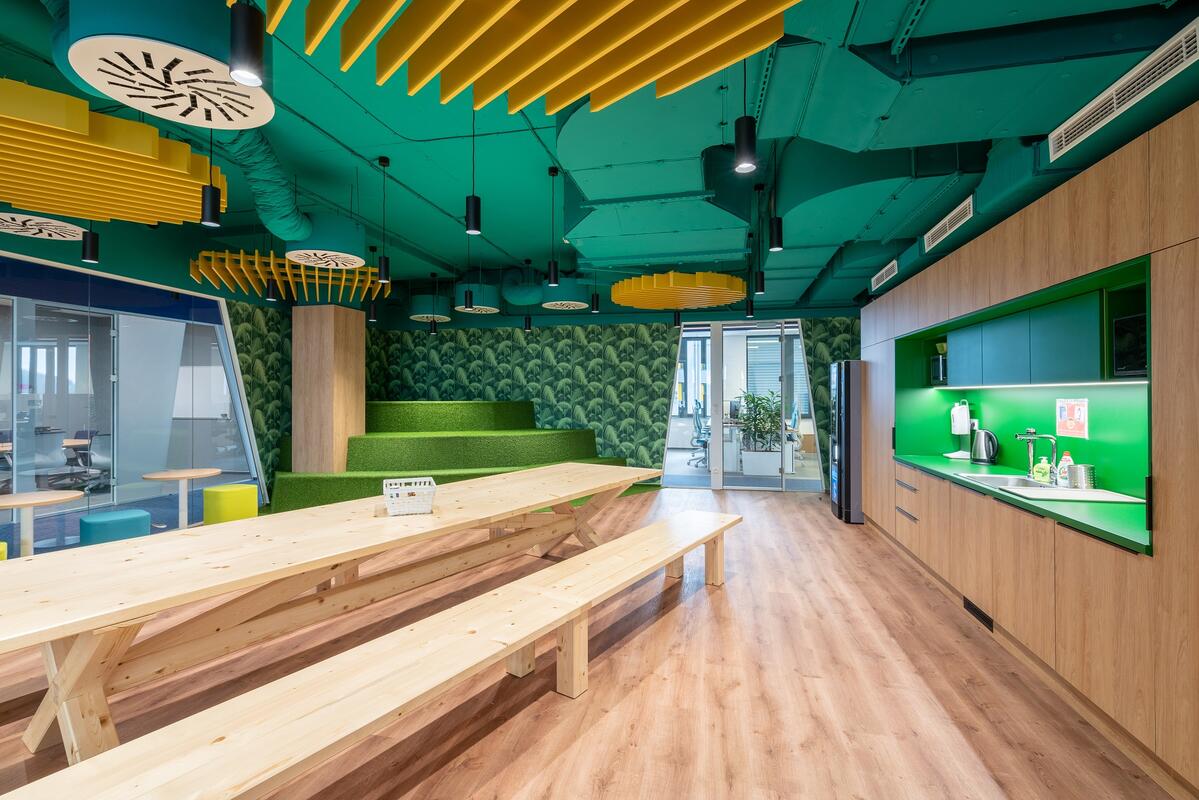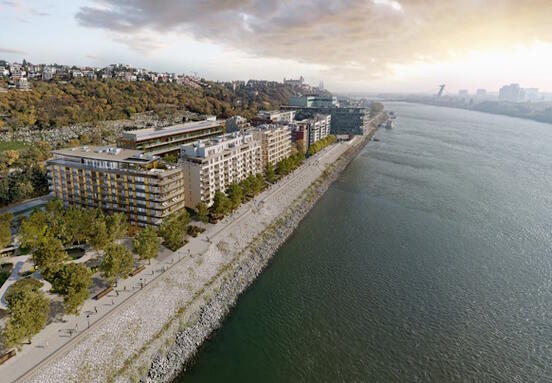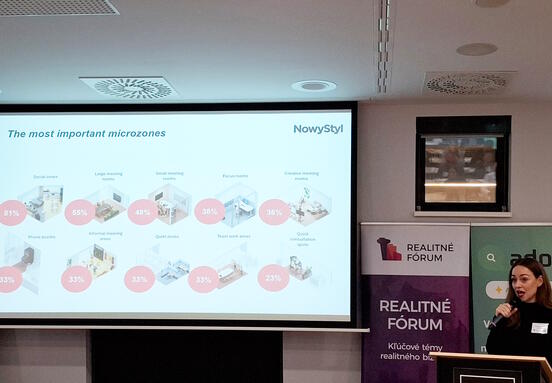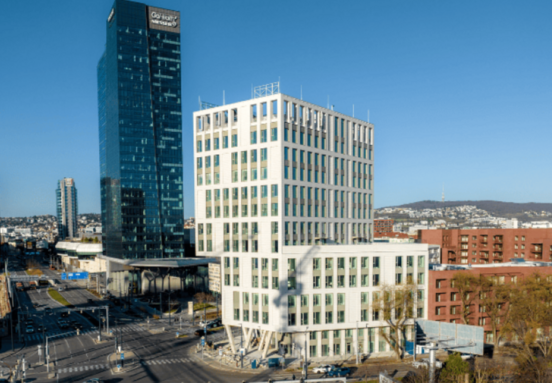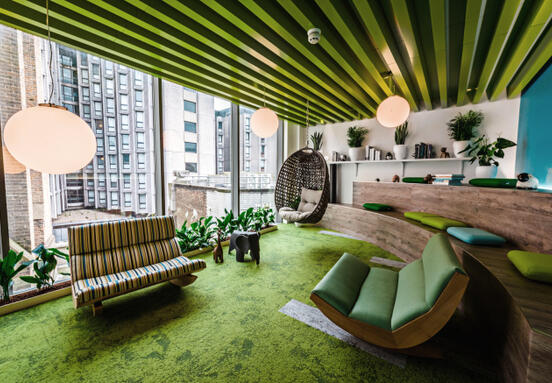The spaces in which we lived, worked, rested, educated and had fun without restrictions before the covid, are slowly but surely entering a new era. How is their character changing? Where did the pandemic actually move us? What is the future of offices?
We sought answers to these questions not only among experts, developers, architects, but also psychologists of architecture.
"Although we all sincerely believe in a return to the original state, we must openly admit that nothing will be the same as before. Although the pandemic, according to many experts, will soon pass, some fears will remain forever in the future. Many of the implemented measures, which we considered temporary, may become permanent and greater emphasis on health and safety will significantly affect the design principles of all spaces, including the administration, "says architect Zuzana Zacharová from DF CREATIV GROUP.
"Our work style has changed and the architecture should respond flexibly. Community office life is not just about work, but especially about communication, stimulation for creativity and short-term rest, "thinks Zuzana Zacharová.
Our work style has changed and the architecture is responding. Short-term rest areas, such as the HB Reavis offices, have also gradually been integrated into the austere work structure. | Source: HB Reavis
Community life as a basis for quality relationships
In the past, offices were mainly the company's business card. They represented her externally, and internal life seemed to be hidden. "Emphasis was placed on the efficient use of space, especially in large offices. The worker was expected to work focused for the full eight hours, and maximum performance was required in a minimum of space.
The design focused on furniture ergonomics, suitable lighting and high-quality technical infrastructure. Paradoxically, productivity did not grow. And so the space for short-term rest or informal communication of employees gradually began to be integrated into the austere work structure, the so-called relax rooms or coffe break corners. The interior began to increasingly reflect the company's values and staff structure.
Libraries, tuli bags, basketball hoops, relaxation chairs, residential kitchens, so-called meeting points, etc., ”says Zuzana Zacharová. Today they are also created in our country. The individual, his comfort, creativity, ideas come to the fore. And also community building.
Interpersonal interaction During the pandemic, JTRE experienced significant effects on the working environment. "The first was working from home as an immediate response to a situation that suddenly came with the onset of a pandemic," says Peter Píš, director of the commercial real estate department at JTRE.
"Even traditional companies suddenly found that it was possible to work from home. Some of them have raised it to the point that they do not need their own offices. However, this would have an impact on management in the medium term, as the new management directions are based on cooperation in teams, which is in contrast to the home office, ”explains Píš. The second effect was the reduction of premises, which only reflected the situation associated with working from home.
"Some companies have tried to reduce costs in this way, if the rental conditions allow it. The third was a recurring lockdown as a constraint to go to work, conduct inspections and meet. Despite the fact that some companies are only gradually returning to the offices and still have a high share of work from home, we do not feel much pressure to adjust leases and reduce leased space. Previously, everyone expected that the pandemic would end once and everything would return to normal, "adds Peter Píš, director of the commercial real estate department at JTRE.
Most people at work essentially want basic things, and it is interesting that the offices have not been able to meet these needs for a long time.
"People want spaces that best support their specific work activities (individual and group) and at the same time allow them to spend time in a quality team to the extent and intensity in line with their personality and preferences. Workspace design has long been approached rather superficially, and many larger companies expect to be able to scale and replicate the same solutions when designing offices.
However, only through a qualitative approach to individual employees and teams can we create an environment that allows them to use their full potential. And this will become more and more critical, because work that will not be quickly automated requires creativity, deep concentration and lively, deep interpersonal interaction, ”explains architecture psychologist Michal Matloň. Every such event has always brought innovations in history.
"Working from home was previously considered a pleasant benefit, but in the long run it is not suitable for everyone, whether for the nature of the work performed or for the lack of facilities in the household. In addition, humans are social creatures and need to meet. No online meetings will fully replace personal communication. It is also difficult to build corporate culture, loyalty, trust, collegial or business relationships at a distance. People want to return to work and the work environment can be adapted to the new situation as it is naturally constantly changing and evolving, "says Peter Píš.
"I think that the design of quality offices for most companies where mental work is done should in the near future be based on three pillars: individual concentration, intensive project work and physical socialization," adds Matloň.
Happiness at work
Happy and healthy employees are more productive. This is a fact that is confirmed by many studies and statistics. If we combine this fact with an in-depth understanding of health, hygiene, possible spread of diseases or the importance of mental health, we will find that the future of buildings will be about their design, especially with regard to a healthy working environment, ideally based on a certificate such as WELL.
"Since many employees struggle with less movement and loneliness when working from home, it can be so-called. wellbeing one of the main factors that get people back to (safe) offices, ”thinks Martin
HB Reavis, head of smart workspace design & solutions, adds: “The current situation has helped us discover the benefits, but also the limits of video conferencing. Regardless, the workspace of the future will be a combination of the virtual and physical worlds. So the next logical step will be to explore how virtual and mixed reality could enhance our online experiences or work tools and collaboration.
The younger generations, who are used to games in virtual reality, will learn these technologies quickly. When leading technology companies get into the mixed reality equipment sector, we could see our colleagues 'holograms in two years' time. ”
All the mentioned trends would have disappeared in a few years anyway. "Covid has accelerated their prioritization by at least five years. But one thing is certain - the purpose of the office is changing. The physical space will thus serve primarily to build the company's trust and culture, which will increase the pace of innovation and mutual learning, "adds Martin Neštepný.
Timeless flexibility
Hybrid workplaces are becoming a space that offers a great deal of flexibility - both spatial and temporal. It is the flexible work environment oriented to the needs of its user that will become a unique competitive advantage for every conscious employer who is not indifferent to productivity or building a corporate culture and is aware of their deep need for their growth.
We already know that working from home will become a standard rather than a benefit, and the benefits of HR departments will receive a physical work environment, the qualities of which will have to be significantly higher and take into account attributes such as cooperation, community, flexibility or security. smart technologies that will serve people and fulfill their daily tasks, and their extent is likely to be assessed more often in real time. Innovations are faster and smarter. Related to this are the growing demands on companies - to grow rapidly while shrinking their teams, pooling and combining their resources and adapting to changing markets.
"Buildings will also react more flexibly - coworking and retail premises will serve as" buffers "for the possible needs of enlarging or reducing companies in real time," explains Martin Neštepný from HB Reavis.
The building also has a life
Today, the life cycle of buildings is much shorter than in the past. "It is therefore very important that they can be adapted without the need for major building modifications or demolition, which is also related to the growing demands for environmental sustainability," says Peter Píš from JTRE.
All trends draw attention to sustainability. The European Union has made a commitment to reduce its carbon footprint to zero by 2050, which will create a re-movement of tenants in the medium and long term. Attention is also focused on greener buildings, whether in terms of energy efficiency or the use of environmental technologies and construction methods. According to the development company JTRE, the redesign of office buildings into apartment buildings is not a novelty either. "Older buildings often cannot be adapted to the current requirements of companies, so it may be more advantageous to turn them into housing. Especially if they are in an attractive location. "
